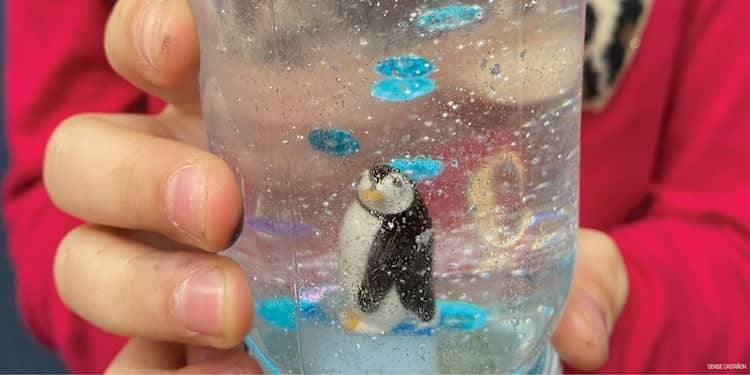This fun winter craft from Yellow Scope science kits also demonstrates a scientific concept to your kids.

What kid doesn’t love a snow globe? Not only does this craft project result in a one-of-a-kind version, it teaches kids the concept of viscosity. And while your kids can create a traditional snowy winter scene, they could just as easily create an underwater tableau with mermaids, sharks or fish; a prehistoric display with dinos and volcanoes; or anything else they can think up. Pro tip: Ceramic or plastic figures and toys work best in a snow globe. Avoid using wood and metal.

Materials
Newspaper or placemat
Empty, clear jar with a screw-top lid
Small toys and decorations
A glue that is not water-based, such as Super Glue or epoxy
Glycerin
White or colored glitter or sequins
A chopstick or long spoon
Water
Instructions
1. Line a flat work surface with newspaper or a placemat. Place the jar lid on top of the newspaper.
2. Set your toys or decorations in the jar lid in an arrangement that you like. Check to make sure that the jar will fit over the items. (Nothing should stick out beyond the lid borders).
3. Carefully glue your items to the lid. (A grown-up should help with this part!)
4. Set the lid aside to dry.
5. Fill 1/3 of the jar with glycerin. Add a small amount of glitter or sequins.
6. Using a chopstick or spoon, mix the glitter into the glycerin. (Observe what happens to the glitter.)
7. Adding water, fill the jar almost to the top. Stir again. Add more glitter if you like.
8. Now add water to fill the jar completely — all the way to the very top.
9. Check the lid to make sure the glue has completely dried and your items are stuck solidly in place.
10. Place the jar in the sink or a tray. Turn your decorated lid over and slowly screw it onto the jar. The water will spill a bit over the sides, but that’s good — it will help to keep bubbles out of the finished snow globe.
11. Dry off your snow globe. Feel free to add more decorations, such as ribbon, to the jar lid.
Why does the glitter fall slowly in my snow globe?
How things flow has to do with viscosity. Viscosity is a measure of how “thick” a liquid is. Water has a low viscosity, meaning it is a rather “thin” liquid. In other words, glitter moves around very easily when you stir it in water! But glycerin, as you noticed in the project, is thicker; it has a higher viscosity. You likely noticed that, even when vigorously stirred, the glitter barely moved in the glycerin!
Adding water to the glycerin creates a liquid with a medium amount of viscosity. That way the glitter falls slowly, more like snow, rather than staying suspended for hours. (As it would if you only used glycerin without any water!)
Chelsea Schuyler is a blogger and social media marketer for Yellow Scope. An avid science nerd, she believes in getting kids (and adults) learning with their hands and their laughter.
